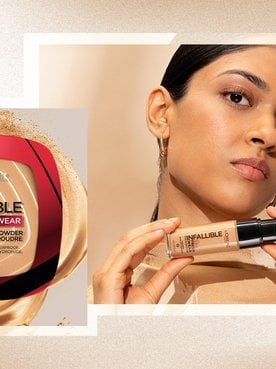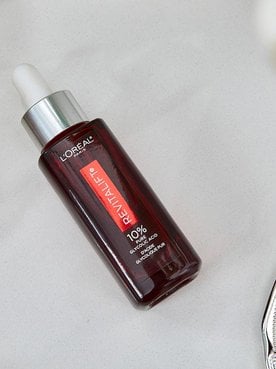In the ‘90s and early aughts, facial astringents were considered a core component of a typical skincare routine. If you’re wondering, “What is an astringent?” you’re not out of the loop—thanks to the popularity of K-beauty and the growing emphasis on skin barrier care, astringents have largely been phased out and replaced with facial toners. The two products are similar in some ways, but astringents tend to be stronger and aren’t suitable for all skin types.
Below, we’ll answer some common questions about astringents (like: What does astringent do, exactly?), explain the differences between facial astringents and toners, and reveal who should—and shouldn’t—give an astringent skin cleanser a try.
What Is An Astringent?
An astringent is a type of liquid skincare product designed to help reduce excess oil and shine. They may also help minimize the appearance of enlarged pores (though it’s worth noting that nothing can actually shrink your pores).
Generally speaking, most astringents are made with high concentrations of alcohol, which can be drying (especially for those with dry or sensitive skin). However, there are also alcohol-free astringents made with ingredients such as witch hazel. They’re milder than their alcohol-based counterparts but also less harsh on the skin.
Astringent vs. Toner What’s the Difference?
The difference between astringents and toners lies in their ingredients and purpose. Astringents, as mentioned, are typically alcohol-based and designed to reduce oiliness. Toners, on the other hand, are often alcohol-free. They can also help address a wider range of concerns, from dryness to dullness and discoloration, depending on the formula.
The L’Oréal Paris RevitaLift Derm Intensives 5% Glycolic Acid Peeling Toner, for example, helps remove dead skin cells, smooths skin texture, and diminishes the appearance of dark spots over time. It’s alcohol-free and fragrance-free and suitable for all skin types, even sensitive skin. We suggest using it twice daily after cleansing to help support a fresh, glowing complexion.

Alcohol-based astringents are typically very drying, and in general, should be avoided. Contrary to popular belief, drying out oily skin isn’t a good thing. In fact, stripping your skin of its natural oils could prompt your body to create more oil, which may lead to clogged pores and breakouts, per the American Academy of Dermatology (AAD). Alcohol-free astringents, however, may be beneficial for those with oily or blemish-prone skin—though if you’re unsure about adding a product to your routine, it’s always a good idea to consult your dermatologist.
If you have sensitive, dry, or combination skin, we suggest using a toner instead. As mentioned, there are options for every skin type and concern, so you shouldn’t have trouble finding one that suits your needs.
Pros of using an astringent
- Oil control: Astringents can help dry out the skin and diminish excess oil and shine.
- Minimizes the appearance of pores: By drying out the skin, astringents may (temporarily) minimize the appearance of enlarged pores.
- Refreshing sensation: Facial astringents provide a refreshing, deep-clean feel, which some people enjoy.
Cons of using an astringent
- Skin dryness: Astringents can cause dryness or irritation, especially if you already have sensitive or dry skin.
- Sensitivity: Alcohol-based astringents can irritate sensitive skin, contributing to redness and discomfort.
- Skin barrier disruption: Overusing astringents can strip the natural oils from your skin and damage the skin’s natural moisture barrier.
How To Use an Astringent in Your Skincare Routine
If you want to try using an astringent in your routine, you’ll want to choose your product carefully. In general, the best facial astringents are those made without alcohol (read the label on your chosen astringent carefully if you’re unsure whether or not it contains alcohol). Once you’ve selected a product, follow these steps.
Step 1: Remove impurities
Double cleansing is a Korean beauty technique that involves washing your face twice to thoroughly remove all makeup, excess oil, and impurities. The technique can be suitable for anyone, but we’re especially fond of the approach for those with oily skin.
To start, remove your makeup with the L’Oréal Paris RevitaLift Radiant Smoothing Wet Cleansing Towelettes. These convenient towelettes remove makeup and impurities while gently exfoliating to help support smooth, radiant-looking skin.
For a more gentle option, especially if you plan to use an exfoliating cleanser in the next step, try using micellar water—just soak a clean cotton round in your chosen formula and swipe it over your skin to remove oil, makeup, and other debris.
Step 2: Select a cleanser for your needs
The second step in your double cleanse should be to lather up with a cleanser that works for your skin's needs. If you need some recommendations, we love the L’Oréal Paris RevitaLift 3.5% Pure Glycolic Acid Cleanser. It contains glycolic acid and salicylic acid and gently exfoliates to reveal smoother, brighter-looking skin over time. The L'Oréal Paris RevitaLift Radiant Smoothing Cream Cleanser is also a great pick. It’s made with vitamin C and helps nourish the skin while removing makeup and other impurities.
Shop the Products
Step 3: Grab your astringent
Next, reach for the product of the hour. Saturate a cotton pad with your astringent and gently swipe it across your face, focusing on your oiliest areas. Typically, this means the T-zone—in other words, your nose, forehead, and chin.
Step: 4: Apply a serum
Next, target your skin concerns with a facial serum. As is the case with toners, there are facial serums for nearly every skin type and concern—you’ll want to select one that aligns with your needs.
If you want to restore moisture after using your astringent, a hydrating serum will be your best bet. The L’Oréal Paris RevitaLift 1.5% Pure Hyaluronic Acid Serum is among our favorites—it delivers intense hydration and leaves the skin looking dewy without a tacky or greasy feel. Plus, the non-comedogenic formula is suitable for all skin types, including acne-prone skin.
The L’Oréal Paris Bright Reveal 12% [Niacinamide + Amino Sulfonic + Ferulic Acid] Dark Spot Serum is another great option suitable for all skin types. The brightening formula helps fade the appearance of dark spots and discolorations to reveal fresh, luminous-looking skin with continued use.
Finally, if large pores are among your top concerns, we suggest trying the L’Oréal Paris RevitaLift Vitamin C+E Salicylic Acid Serum. This vitamin C serum helps minimize the appearance of large pores, evens skin tone and texture, and reduces the appearance of fine lines.
Shop the Products
Step 5: Apply moisturizer with SPF
No matter your skin type, moisturizing is a must—and that goes doubly if you’re using an astringent. During the daytime, we love using an SPF moisturizer to help hydrate the skin and protect it from the sun’s harmful rays.
One of our favorites in this category is the L’Oréal Paris RevitaLift Triple Power Day Lotion SPF 30. It contains hyaluronic acid, vitamin C, and pro-retinol and helps firm, brighten, and reduce the appearance of wrinkles in as little as one week. The L’Oréal Paris Age Perfect Collagen Expert Day Moisturizer with SPF 30 is another excellent pick, particularly for those with dry, mature skin. The dermatologist-tested formula with niacinamide and collagen peptides provides intense, all-day hydration without a greasy or sticky feel. Plus, the broad-spectrum SPF 30 sunscreen in its formula helps shield the skin from both UVA and UVB rays. And if your main priority is to target the visible signs of aging, try the antioxidant-packed L’Oréal Paris Age Perfect Cell Renewal Anti-Aging Day Moisturizer SPF 25. It’s designed to help firm the skin, diminish wrinkles, and support the skin’s natural recovery processes.
Finally, remember that even if you’re using an SPF moisturizer, you’ll want to follow other sun protection measures, too. Avoid direct sunlight at midday, seek shade whenever possible, and wear protective clothing (like hats) to help shield your skin from the sun’s damaging rays.
Shop the Products
Next Up: 11 Do’s and Don’ts for Washing Your Face
Photo courtesy of L’Oréal Paris







